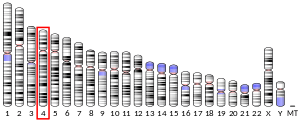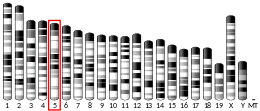KCNIP4
Kv channel-interacting protein 4 is a protein that in humans is encoded by the KCNIP4 gene.[5][6][7]
This gene encodes a member of the family of voltage-gated potassium (Kv) channel-interacting proteins (KCNIPs), which belong to the recoverin branch of the EF-hand superfamily.[8] Members of the KCNIP family are small calcium binding proteins. They all have EF-hand-like domains, and differ from each other in the N-terminus. They are integral subunit components of native Kv4 channel complexes. They may regulate A-type currents, and hence neuronal excitability, in response to changes in intracellular calcium. This protein member also interacts with presenilin. Multiple alternatively spliced transcript variants encoding distinct isoforms have been identified for this gene.[7]
Interactions
KCNIP4 has been shown to interact with PSEN2.[6]
See also
References
- ENSG00000281758 GRCh38: Ensembl release 89: ENSG00000185774, ENSG00000281758 - Ensembl, May 2017
- GRCm38: Ensembl release 89: ENSMUSG00000029088 - Ensembl, May 2017
- "Human PubMed Reference:". National Center for Biotechnology Information, U.S. National Library of Medicine.
- "Mouse PubMed Reference:". National Center for Biotechnology Information, U.S. National Library of Medicine.
- Holmqvist MH, Cao J, Hernandez-Pineda R, Jacobson MD, Carroll KI, Sung MA, Betty M, Ge P, Gilbride KJ, Brown ME, Jurman ME, Lawson D, Silos-Santiago I, Xie Y, Covarrubias M, Rhodes KJ, Distefano PS, An WF (Jan 2002). "Elimination of fast inactivation in Kv4 A-type potassium channels by an auxiliary subunit domain". Proc Natl Acad Sci U S A. 99 (2): 1035–40. doi:10.1073/pnas.022509299. PMC 117799. PMID 11805342.
- Morohashi Y, Hatano N, Ohya S, Takikawa R, Watabiki T, Takasugi N, Imaizumi Y, Tomita T, Iwatsubo T (Apr 2002). "Molecular cloning and characterization of CALP/KChIP4, a novel EF-hand protein interacting with presenilin 2 and voltage-gated potassium channel subunit Kv4". J Biol Chem. 277 (17): 14965–75. doi:10.1074/jbc.M200897200. PMID 11847232.
- "Entrez Gene: KCNIP4 Kv channel interacting protein 4".
- Burgoyne RD (2007). "Neuronal calcium sensor proteins: generating diversity in neuronal Ca2+ signalling". Nat. Rev. Neurosci. 8 (3): 182–193. doi:10.1038/nrn2093. PMC 1887812. PMID 17311005.
Further reading
- Strausberg RL; Feingold EA; Grouse LH; et al. (2003). "Generation and initial analysis of more than 15,000 full-length human and mouse cDNA sequences". Proc. Natl. Acad. Sci. U.S.A. 99 (26): 16899–903. doi:10.1073/pnas.242603899. PMC 139241. PMID 12477932.
- Lin YL, Lin SR, Wu TT, Chang LS (2004). "Evidence showing an intermolecular interaction between KChIP proteins and Taiwan cobra cardiotoxins". Biochem. Biophys. Res. Commun. 319 (3): 720–4. doi:10.1016/j.bbrc.2004.05.064. PMID 15184042.
- Gerhard DS; Wagner L; Feingold EA; et al. (2004). "The status, quality, and expansion of the NIH full-length cDNA project: the Mammalian Gene Collection (MGC)". Genome Res. 14 (10B): 2121–7. doi:10.1101/gr.2596504. PMC 528928. PMID 15489334.
- Hillier LW; Graves TA; Fulton RS; et al. (2005). "Generation and annotation of the DNA sequences of human chromosomes 2 and 4". Nature. 434 (7034): 724–31. doi:10.1038/nature03466. PMID 15815621.
- Pruunsild P, Timmusk T (2005). "Structure, alternative splicing, and expression of the human and mouse KCNIP gene family". Genomics. 86 (5): 581–93. doi:10.1016/j.ygeno.2005.07.001. PMID 16112838.
- Chen CP, Lee L, Chang LS (2007). "Effects of metal-binding properties of human Kv channel-interacting proteins on their molecular structure and binding with Kv4.2 channel". Protein J. 25 (5): 345–51. doi:10.1007/s10930-006-9020-9. PMID 16951992.
- Ewing RM; Chu P; Elisma F; et al. (2007). "Large-scale mapping of human protein-protein interactions by mass spectrometry". Mol. Syst. Biol. 3 (1): 89. doi:10.1038/msb4100134. PMC 1847948. PMID 17353931.
- Bonne A; Vreede L; Kuiper RP; et al. (2008). "Mapping of constitutional translocation breakpoints in renal cell cancer patients: identification of KCNIP4 as a candidate gene". Cancer Genet. Cytogenet. 179 (1): 11–8. doi:10.1016/j.cancergencyto.2007.07.005. PMID 17981209.
External links
- KCNIP4+protein,+human at the US National Library of Medicine Medical Subject Headings (MeSH)
This article incorporates text from the United States National Library of Medicine, which is in the public domain.



